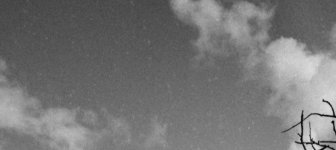- Messages
- 86
- Name
- Peter
- Edit My Images
- No
Hi all
I have been having the same "dust" marks problem with the last 3 negatives I developed. What is strange is this problem has repeatedly appeared on the negatives despite the fact I've been using different film, different developer and even fresh stop bath & fixer. It even appears over the negatives regardless of the lens shot with. So the only constant has been the camera body (Rollei SL66).
Here is a scanned negative that shows the problem, with a zoomed in snapshot under that.


The negative above was shot on Ilford FP4. Developed with Rodinal for 15 mins 1:50 dilution, with a 1 min stop bath then 8 min fix and 15 min wash. These "dust" artefacts appeared across every negative on the roll. The roll was developed with freshly mixed stop bath and fixer.
They also appeared exactly like above on another roll of Ilford FP4 developed with Kodak HC-110, with a 1 min stop bath then 8 min fix and 15 min wash. And then on a roll of Fuji Acros II developed with Kodak HC-110, with a 1 min stop bath then 8 min fix and 15 min wash.
It seems the "dust" spots are on the film as soon as I take it out the tank which means they have occurred during development, and so its not an issue of the films gathering dust in the negative drying cabinet. EDIT - *The marks are ingrained into the negatives and not on top of the surface of the film.*
I am completely lost as to what is causing these annoying artefacts. I would really appreciate it anyone has any ideas what is causing this?
Thanks!
I have been having the same "dust" marks problem with the last 3 negatives I developed. What is strange is this problem has repeatedly appeared on the negatives despite the fact I've been using different film, different developer and even fresh stop bath & fixer. It even appears over the negatives regardless of the lens shot with. So the only constant has been the camera body (Rollei SL66).
Here is a scanned negative that shows the problem, with a zoomed in snapshot under that.


The negative above was shot on Ilford FP4. Developed with Rodinal for 15 mins 1:50 dilution, with a 1 min stop bath then 8 min fix and 15 min wash. These "dust" artefacts appeared across every negative on the roll. The roll was developed with freshly mixed stop bath and fixer.
They also appeared exactly like above on another roll of Ilford FP4 developed with Kodak HC-110, with a 1 min stop bath then 8 min fix and 15 min wash. And then on a roll of Fuji Acros II developed with Kodak HC-110, with a 1 min stop bath then 8 min fix and 15 min wash.
It seems the "dust" spots are on the film as soon as I take it out the tank which means they have occurred during development, and so its not an issue of the films gathering dust in the negative drying cabinet. EDIT - *The marks are ingrained into the negatives and not on top of the surface of the film.*
I am completely lost as to what is causing these annoying artefacts. I would really appreciate it anyone has any ideas what is causing this?
Thanks!
Last edited:

